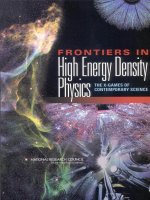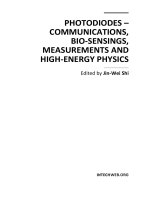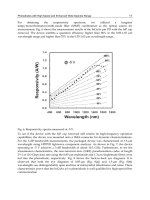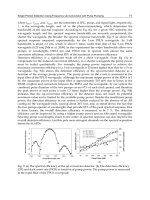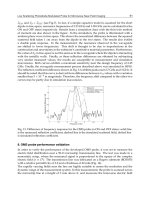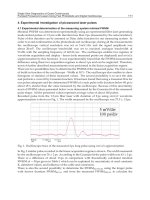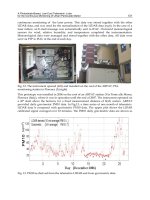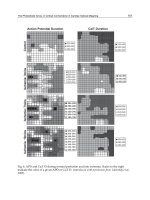- Trang chủ >>
- Khoa Học Tự Nhiên >>
- Vật lý
High energy neutrino astronomy
Bạn đang xem bản rút gọn của tài liệu. Xem và tải ngay bản đầy đủ của tài liệu tại đây (855.69 KB, 83 trang )
arXiv:astro-ph/0204527 v2 8 Jul 2002
High-energy Neutrino Astronomy: The Cosmic Ray Connection
Francis Halzen and D an Hooper
Department of Physics, University of Wisconsin,
1150 University Avenue, Madison, WI 53706
Abstract
This is a review of neutrino astronomy anchored to the observational fact that Nature accelerates
protons and photons to energies in excess of 10
20
and 10
13
eV, respectively.
Although the discovery of cosmic rays dates back close to a century, we do not know how and
where they are accelerated. There is evidence that the highest energy cosmic rays are extra-galactic
— they cannot be contained by our galaxy’s magnetic field anyway because their gyroradiu s far
exceeds its dimension. Elementary elementary-particle physics dictates a universal upper limit
on th eir energy of 5 × 10
19
eV, the so-called Greisen-Kuzmin-Zatsepin cutoff; however, particles
in excess of this energy have been observed by all experiments, adding one more puzzle to the
cosmic ray mystery. Mystery is fertile ground for pr ogress: we will review the facts as well as the
speculations about the sources.
There is a realistic hope that the oldest p roblem in astronomy will be resolved soon by ambitious
experimentation: air shower arrays of 10
4
km
2
area, arrays of air Cerenkov detectors and, the
subject of this review, kilometer-scale neutrino observatories.
We will review why cosmic accelerators are also expected to be cosmic b eam dumps pr oducing
associated high-energy photon and neutrino beams. We will work in detail throu gh an example
of a cosmic beam dump, gamma ray bursts. These are expected to produce neutrinos from MeV
to EeV energy by a variety of mechanisms. We w ill also discuss active galaxies and GUT-scale
remnants, two other classes of sources speculated to be associated with the highest energy cosmic
rays. Gamma ray burs ts an d active galaxies are also the sources of the highest energy gamma rays,
with emission observed up to 20 TeV, possibly higher.
The important conclusion is th at, independently of the specific blueprint of the source, it takes
a kilometer-scale neutrino observatory to detect the neutrino beam associated with the highest
energy cosmic rays and gamma rays. We also briefly review the ongoing efforts to commission such
instrumentation.
Contents
I. The Highest Energy Particles: Cosmic Rays, Photons and Neutrinos 4
A. The New Astronomy 4
B. The Highest Energy Cosmic Rays: Facts 6
C. The Highest Energy Cosmic Rays: Fancy 8
1. Acceleration to > 100 EeV? 8
2. Are Cosmic Rays Really Protons: the GZK Cutoff? 10
3. Could Cosmic Rays be Photons or Neutrinos? 11
D. A Three Prong Assault on the Cosmic Ray Puzzle 13
1. Giant Cosmic Ray Detectors 13
2. Gamma rays from Cosmic Accelerators 14
3. Neutrinos from Cosmic Accelerators 17
II. High-energy Neutrino Telescopes 19
A. Observing High-energy Neutrinos 19
B. Lar ge Natural Cerenkov Detectors 22
1. Baikal, ANTARES, Nestor and NEMO: Northern Water 25
2. AMANDA: Southern Ice 28
3. IceCube: A Kilometer-Scale Neutrino Observato ry 33
C. EeV Neutrino Astronomy 35
III. Cosmic Neutrino Sources 37
A. A List of Cosmic Neutrino Sources 37
B. Gamma Ray Bursts: A Detailed Example of a Generic Beam Dump 39
1. GRB Characteristics 39
2. A Brief History of Gamma Ray Bursts 40
3. GRB Progenitors? 41
4. Fireball Dynamics 42
5. Ultra High-energy Protons From GRB? 47
6. Neutrino Production in GRB: the Many Opportunities 49
7. Thermal MeV Neutrinos from GRB 50
8. Shocked Protons: PeV Neutrinos 51
2
9. Stellar Core Collapse: Early TeV Neutrinos 53
10. UHE Protons From GRB: EeV Neutrinos 55
11. The Decoupling of Neutrons: GeV Neutrinos 57
12. Burst-To-Burst Fluctuations and Neutrino Event Rates 59
13. The Effect of Neutrino Oscillations 61
C. Blazars: the Sources of the Highest Energy Gamma rays 62
1. Blazar Characteristics 62
2. Blazar Mo dels 63
3. Highly Shocked Protons: EeV Blazar Neutrinos 64
4. Moderately Shocked Protons: TeV Blazar Neutrinos 66
D. Neutrinos Associated With Cosmic Rays of Top-Down Origin 67
1. Nucleons in Top-Down Scenarios 68
2. Neutrinos in Top-Down Scenarios 69
IV. The Future for High-energy Neutrino Astronomy 71
Acknowledgments 71
References 71
3
I. THE HIGHEST ENERGY PARTICLES: COSMIC RAYS, PHOTONS AND
NEUTRINOS
A. The New Astronomy
Conventional astronomy spans 60 octaves in photon frequency, from 10
4
cm radio-waves
to 10
−14
cm gamma rays of GeV energy; see Fig. 1. This is an amazing expansion of the power
of our eyes which scan the sky over less than a single octave just above 10
−5
cm wavelength.
This new astronomy probes the Universe with new wavelengths, smaller than 10
−14
cm, or
photon energies larger than 10 GeV. Besides t he traditional signals of astronomy, gamma
rays, gravitational waves, neutrinos and very high-energy protons become astronomical mes-
sengers from the Universe. As exemplified time and again, the development of novel ways
of looking into space invariably results in the discovery of unanticipated phenomena. As is
the case with new accelerators, observing only the predicted will be slightly disappointing.
TeV sources!
cosmic
rays
/
/
/
/
/
/
/
/
/
/
/
/
/
/
/
/
/
ν
FIG. 1: The diffuse flux of photons in the Universe, from radio waves to GeV-photons. Above tens
of GeV, only limits are reported although individual sources emitting TeV gamma rays have been
identified. Above GeV energy, cosmic rays dominate the spectrum.
4
Why pursue high-energy astronomy with neutrinos or protons despite considerable instru-
mental challenges? A mundane reason is that the Universe is not transparent to photons
of TeV energy and above (units are: GeV/TeV/PeV/EeV/ZeV in ascending factors of 10
3
).
For instance, a PeV energy photon cannot deliver information from a source at the edge of
our own galaxy because it will annihilate into an electron pair in an encounter with a 2.7
Kelvin microwave photon before reaching our telescope. In general, energetic photons are
absorbed on background light by pair production γ + γ
bkgnd
→ e
+
+ e
−
of electrons above
a threshold E given by
4Eǫ ∼ ( 2m
e
)
2
, (1)
where E and ǫ are the energy of the high-energy and background photon, respectively.
Eq. (1) implies that TeV-photons are absorbed on infrared light, PeV photons on the cosmic
microwave background and EeV photons on radio-waves; see Fig. 1. Only neutrinos can
reach us without attenuation from the edge of the Universe.
At EeV energies, proton astronomy may be possible. Near 50 EeV and above, the arrival
directions of electrically charged cosmic rays are no longer scrambled by the ambient mag-
netic field of our own galaxy. They po int back to their sources with an accuracy determined
by their gyroradius in the intergalactic magnetic field B:
θ
∼
=
d
R
gyro
=
dB
E
, (2)
where d is the distance to the source. Scaled to units relevant to the problem,
θ
0.1
◦
∼
=
d
1 Mpc
B
10
−9
G
E
3×10
20
eV
. (3)
Speculations on the strength of the inter-galactic magnetic field range from 10
−7
to
10
−12
Gauss in the local cluster. For a distance of 100 Mpc, the resolution may therefore
be anywhere from sub-degree to nonexistent. It is still possible that the arrival directions
of the highest energy cosmic rays provide information on the location of their sources. Pro-
ton astronomy should be possible; it may also provide indirect information o n intergalactic
magnetic fields. Determining the strength of intergalactic magnetic fields by conventional
astronomical means has been challenging.
5
B. The Highest Energy Cosmic Rays: Facts
In October 1991, the Fly’s Eye cosmic ray detector recorded an event of energy 3.0 ±
0.36
0.54
×10
20
eV [1]. This event, together with an event recorded by the Yakutsk air shower array
in May 1989 [2], o f estimated energy ∼ 2 × 10
20
eV, constituted (at the time) the two
highest energy cosmic rays ever seen. Their energy corresponds to a center of mass energy
of the order of 700 TeV or ∼ 50 Joules, almost 50 times the energy of t he Large Hadron
Collider (LHC). In fact, all a ctive experiments [3] have detected cosmic rays in t he vicinity of
100 EeV since their initial discovery by the Haverah Park air shower array [4]. The AGASA
air shower array in Japan[5] has now accumulated an impressive 10 events with energy in
excess of 10
20
eV [6].
The accuracy of the energy resolution of these experiments is a critical issue. With a
particle flux of order 1 event per km
2
per century, these events are studied by using the
earth’s atmosphere as a particle detector. The experimental signature of an extremely high-
energy cosmic particle is a shower initiated by the particle. The primary particle creates
an electromagnetic and hadronic cascade. The electromagnetic shower grows to a shower
maximum, and is subsequently absorbed by the atmosphere.
The shower can be observed by: i) sampling the electromagnetic and hadronic components
when they reach the ground with an ar ray of particle detectors such as scintillators, ii)
detecting the fluorescent light emitted by atmospheric nitrogen excited by the passage of
the shower particles, iii) detecting the Cerenkov lig ht emitted by the large number of particles
at shower maximum, and iv) detecting muons and neutrinos underground.
The bottom line on energy measurement is that, at this time, several experiments using
the first two techniques agree on the energy of EeV-showers within a typical resolution of
25%. Additionally, there is a systematic error of order 10 % associated with the modeling of
the showers. All techniques are indeed subject to the ambiguity of particle simulations that
involve physics beyond the LHC. If the final outcome turns out to be an erroneous inference
of the energy of the shower because of new physics associated with particle interactions at
the Λ
QCD
scale, we will be happy to contemplate this discovery instead.
Could the error in the energy measurement be significantly larger than 25%? The answer
is almost certainly negative. A variety of techniques have been developed to overcome the
fact that conventional air shower arrays do calorimetry by sampling at a single depth. They
6
8
2
10
5
3
2
10
10 10
19 20
10
10
10
23
24
25
26
J(E) E [m sec sr eV ]
3 −2 −1 −1 2
Energy [eV]
AGASA
C
Uniform sources
FIG. 2: The cosmic ray spectrum peaks in the vicinity of 1 GeV and has features near 10
15
and
10
19
eV referred to as the “knee” and “ankle” in the spectrum, respectively. Shown is the flu x of
the highest energy cosmic rays near and beyond the ankle measured by the AGASA experiment.
Note that the flux is multiplied by E
3
.
also give results within the range already mentioned. So do the fluorescence experiments
that embody continuous sampling calorimetry. The latter are subject to understanding the
transmission of fluorescent light in the dark night atmosphere — a challenging problem
given its variation with weather. Stereo fluorescence detectors will eventually eliminate
this last hurdle by doing two redundant measurements of the same shower from different
locations. The HiRes collaborators have one year of data on tape which should allow them
to settle energy calibration once and for all.
The premier experiments, HiRes and AGASA, agree that cosmic rays with energy in
excess of 10 EeV are not galactic in origin and that their spectrum extends beyond 100 EeV.
7
FIG. 3: As in Fig. 2, but as measured by the HiRes experiment.
They disagree on almost everything else. The AGASA experiment claims evidence that
the highest energy cosmic rays come from point sources, and that they are mostly heavy
nuclei. The HiRes data do not support this. Because of such low statistics, interpreting the
measured fluxes as a function of energy is like reading tea leaves; o ne cannot help however
reading different messages in the spectra (see Fig. 2 and Fig. 3).
C. The Highest Energy Cosmic Rays: Fancy
1. Acceleration to > 100 EeV?
It is sensible to assume that, in o r der to accelerate a proto n to energy E in a magnetic
field B, the size R of the accelerator must be larger than the gyroradius of the particle:
R > R
gyro
=
E
B
. (4)
That is, the accelerating magnetic field must contain the particle orbit. This condition yields
a maximum energy
E = γBR (5)
8
TABLE I: Requirements to generate the highest energy cosmic rays in astrophysical sources.
Conditions with E ∼ 10 EeV
• Quasars γ
∼
=
1 B
∼
=
10
3
G M
∼
=
10
9
M
sun
• Blazars γ
>
∼
10 B
∼
=
10
3
G M
∼
=
10
9
M
sun
• Neutron S tars
Black Holes
.
.
.
γ
∼
=
1 B
∼
=
10
12
G M
∼
=
M
sun
• GRB γ
>
∼
10
2
B
∼
=
10
12
G M
∼
=
M
sun
by dimensional analysis and nothing more. The γ-factor has been included to allow for the
possibility that we may not be at rest in the frame of the cosmic accelerator. The result
would be the observation of boosted particle energies. Theorists’ imagination regarding
the accelerators has been limited to dense regions where exceptional gravitational forces
create relativistic particle flows: the dense cores of exploding stars, inflows on supermassive
black holes at the centers of active galaxies, annihilating black holes or neutron stars. All
speculations involve collapsed o bjects and we can therefore replace R by the Schwartzschild
radius
R ∼ GM/c
2
(6)
to obtain
E ∝ γBM . (7)
Given the microgauss magnetic field of our ga laxy, no structures are large or massive enough
to reach the energies of the highest energy cosmic rays. Dimensional analysis therefore limits
their sources to extragalactic objects; a few common speculations are listed in Table 1.
Nearby active galactic nuclei, distant by ∼ 100 Mp c and powered by a billion solar mass
black holes, are candidates. With kilogauss fields, we reach 100 EeV. The jets (blazars)
emitted by the central black hole could reach similar energies in accelerating substructures
(blobs) boosted in our direction by Lorentz factors of 10 or possibly higher. The neutron
star or black hole remnant of a collapsing supermassive star could support magnetic fields
of 10
12
Gauss, possibly larger. Highly relativistic shocks with γ > 10
2
emanating from the
collapsed black hole could be the origin of gamma ray bursts and, possibly, the source of
the highest energy cosmic rays.
9
The above speculations are reinforced by the fact that the sources listed are also the
sources of the highest energy gamma rays observed. At this point, however, a reality check
is in order. The above dimensional analysis applies to the Fermilab accelerator: 10 kilogauss
fields over several kilometers correspo nds to 1 TeV. The argument holds because, with opti-
mized design and perfect alignment of magnets, the a ccelerator reaches efficiencies matching
the dimensional limit. It is highly questionable that nature can achieve this feat. Theorists
can imagine acceleration in shocks with an efficiency of perhaps 10%.
The astrophysics problem of obtaining such high-energy particles is so daunting that many
believe that cosmic rays are not the beams of cosmic accelerators but the decay products
of remnants from the early Universe, such as topological defects associated with a Grand
Unified Theory (GUT) phase transition.
2. Are Cosmic Rays Really Protons: the GZK Cutoff?
All experimental signatures agr ee on the particle nature of the cosmic rays — they look
like protons or, p ossibly, nuclei. We mentioned at the beginning of this article that the
Universe is opaque to photons with energy in excess of tens of TeV because they annihilate
into electron pairs in interactions with the cosmic microwave background. Protons also
interact with background light, predominantly by photoproduction of the ∆-resonance, i.e.
p + γ
CMB
→ ∆ → π + p above a threshold energy E
p
of about 50 EeV given by:
2E
p
ǫ >
m
2
∆
− m
2
p
. (8)
The major source of proton energy loss is photoproduction of pions on a target of cosmic
microwave photons of energy ǫ. The Universe is, therefore, also opaque to the highest energy
cosmic rays, with an absorption length of
λ
γp
= (n
CMB
σ
p+γ
CMB
)
−1
(9)
∼
=
10Mpc, (10)
when their energy exceeds 50 EeV. This so-called GZK cutoff establishes a universal upper
limit on the energy of the cosmic rays. The cutoff is robust, dep ending only on two known
numbers: n
CMB
= 400 cm
−3
and σ
p+γ
CMB
= 10
−28
cm
2
[8, 9, 10, 11].
Protons with energy in excess of 100 EeV, emitted in distant quasars and gamma ray
bursts, will lose their energy to pions before reaching our detectors. They have, nevertheless,
10
been observed, as we have previously discussed. They do not point to any sources within
the GZK-horizon however, i.e. to sources in our local cluster of galaxies. There are three
possible resolutions: i) t he protons are accelerated in nearby sources, ii) they do reach us
from distant sources which accelerate them to even higher energies than we observe, thus
exacerbating t he acceleration problem, o r iii) the highest energy cosmic rays are not protons.
The first possibility raises the challenge of finding an appropriate accelerator by confining
these already unimaginable sources to our local galactic cluster. It is not impossible that all
cosmic rays are produced by the active galaxy M87, or by a nearby gamma r ay burst which
explo ded a few hundred years ago.
Stecker [12] has speculated that the highest energy cosmic rays are Fe nuclei with a
delayed GZK cutoff. The details are complicated but the relevant quantity in the problem
is γ = E/AM, where A is the atomic number and M the nucleon mass. For a fixed observed
energy, the smallest boost above GZK threshold is associated with the largest atomic mass,
i.e. Fe.
3. Could Cosmic Rays be Photons or Neutrinos?
Topological defects predict that the highest energy cosmic rays are predominantly pho-
tons. A topolo gical defect will suffer a chain decay into GUT particles X and Y, that
subsequently decay to fa miliar weak bosons, leptons and quark or gluon jets. Cosmic rays
are, therefore, predominately the fragmentation products o f these jets. We know from accel-
erator studies that, among the frag mentation products of jets, neutral pions (decaying into
photons) dominate, in number, protons by close to two orders of magnitude. Therefore, if
the decay of topological defects is the source of the highest energy cosmic rays, they must
be photons. This is a problem because there is compelling evidence that the highest energy
cosmic rays are not photons:
1. The highest energy event observed by Fly’s Eye is not likely to be a photon [7]. A
photon of 300 EeV will interact with the magnetic field of the earth far above the atmosphere
and disintegrate into lower energy cascades — ro ug hly ten at this particular energy. The
detector subsequently collects light produced by the fluorescence of atmospheric nitrogen
along the path of the high-energy showers traversing the atmosphere. The anticipated
shower profile of a 300 EeV photon is shown in Fig. 4. It disagrees with the data. The
11
FIG. 4: The composite atmospheric shower profile of a 3 ×10
20
eV gamma ray shower calculated
with Landau-Pomeranchuk-Migdal (dashed) and Bethe-Heitler (solid) electromagnetic cross sec-
tions. The central line shows the average shower profile and the upper and lower lines show 1 σ
deviations — not visible for the BH case, where lines overlap. The experimental shower profile is
shown with the data points. It does not fit the profile of a photon shower.
observed shower profile does fit that of a primary pro t on, or , possibly, that of a nucleus.
The shower profile information is sufficient, however, to conclude that the event is unlikely
to be of photon origin.
2. The same conclusion is reached for the Yakutsk event that is characterized by a huge
number of secondary muons, inconsistent with an electromagnetic cascade initiated by a
gamma ray.
3. The AGASA collaboration claims evidence for “point” sources above 10 EeV. The
arrival directions are however smeared out in a way consistent with primaries deflected by
the galactic magnetic field. Again, this indicates charged primaries and excludes photons.
12
4. Finally, a recent reanalysis of the Haverah Park disfavors photon origin of the primaries
[4].
Neutrino primaries are definitely ruled out. Standard model neutrino physics is under-
stood, even for EeV energy. The average x of the parton mediating the neutrino interaction
is of order x ∼
M
2
W
/s ∼ 10
−6
so that the perturbative result for the neutrino-nucleus
cross section is calculable from measured HERA structure functions. Even at 100 EeV a
reliable value of the cross section can be obtained based on QCD- inspired extrapolat io ns
of the structure function. The neutrino cross section is known to better than an order of
magnitude. It falls 5 orders of magnitude short of the strong cross sections required to make
a neutrino interact in the upper atmosphere to create an air shower.
Could EeV neutrinos be strongly interacting because of new physics? In theories with
TeV-scale gravity, one can imagine that graviton exchange dominates all interactions and
thus erases the difference between quarks and neutrinos at the energies under consideration.
The actual models performing this feat require a fast turn-on of the cross section with energy
that violates S-wave unitarity [13, 14, 15, 16, 17, 18, 19, 20, 21, 22, 23].
We have exhausted the possibilities. Neutrons, muons and other candidate primaries one
may think of a re unstable. EeV neutrons barely live long enough to reach us from sources
at t he edge of our galaxy.
D. A Three Prong Assault on the Cosmic Ray Puzzle
We conclude that, where the highest energy cosmic rays are concerned, both the ac-
celerator mechanism and the particle physics are enigmatic. The mystery has inspired a
worldwide effort to tackle the problem with novel experimentation in three complementary
areas of r esearch: air shower detection, atmospheric Cerenkov astronomy and underground
neutrino astronomy. While some of the future instruments have additional missions, all are
likely to have a major impact on cosmic ray physics.
1. Giant Cosmic Ray De tectors
With super- GZK fluxes of t he order of a single event per square kilometer, per century,
the outstanding problem is the lack of statistics; see Fig. 2 and Fig. 3. In the next five years,
13
a qualitative improvement can be expected from the operation of the HiRes fluorescence
detector in Utah. With improved instrumentation yielding high quality data from 2 detectors
operated in coincidence, the interplay between sky transparency and energy measurement
can be studied in detail. We can safely anticipate that the existence of super-GZK cosmic
rays will be conclusively demonstrated by using the instrument’s calorimetric measurements.
A mostly Japanese collaboration has proposed a next-generation fluorescence detector, the
Telescope Array.
The Auger air shower array is confronting t he low rate problem with a huge collection
area covering 3000 square kilometers on an elevated plain in Western Argentina. The in-
strumentation consists of 1600 water Cerenkov detectors spaced by 1.5 km. For calibration,
about 15 percent of the showers occurring at night will be viewed by 3 HiRes-style fluores-
cence detectors. The detector is expected to observe several t housand events per year above
10 EeV and tens above 10 0 EeV. Exact numbers will depend on the detailed shape of the
observed spectrum which is, at present, a matter of speculation.
2. Gamma rays from Cosmic Accelerators
An alternative way to identify the source(s) of the highest energy cosmic rays is illustrated
in Fig. 5. The cartoon draws our attention to the fact that cosmic accelerators are also cosmic
beam dumps which produce secondary photon and neutrino beams. Accelerating particles to
TeV energy and above requires relativistic, massive bulk flows. These are likely to originate
from the exceptional gravitational for ces associated with dense cores of exploding stars,
inflows onto supermassive black holes at the centers of active galaxies, annihilating black
holes or neutron stars. In such situations, accelerated particles are likely to pass through
intense radiation fields or dense clouds of gas surrounding the black hole. This leads to
the production of secondary photons and neutrinos that accompany the primary cosmic
ray beam. An example of an electromagnetic beam dump is the UV radiation field that
surrounds the central black hole of active galaxies. The target material, whether a gas of
particles or of photons, is likely to be tenuous enough that the primary beam and the photon
beam are only partially attenuated. However, shrouded sources from which only neutrinos
can emerge, as in terrestrial beam dumps at CERN and Fermilab, are also a possibility.
The astronomy event of the 21st century could be the simultaneous observation of TeV-
14
FIG. 5: Diagram of cosmic accelerator and beam dump. See text for discussion.
gamma rays, neutrinos and gravitational waves from cataclysmic events associated with the
source of the highest energy cosmic rays.
We first concentrate on the possibility of detecting high-energy photon beams. Af-
ter two decades, ground-based gamma ray astronomy has become a mature science
[24, 25, 26, 27, 28, 29]. A large mirror, viewed by an array of photomultipliers, collects
the Cerenkov light emitted by air showers and images the showers in order to determine the
arrival direction and the nature of the primary particle. These experiments have o pened
a new window in astronomy by extending the photo n spectrum to 20 TeV, and possibly
beyond. Observations have revealed spectacular TeV-emission from galactic supernova rem-
nants and nearby quasars, some of which emit most of their energy in very short bursts of
TeV-photons.
But there is the dog that didn’t bark. No evidence has emerged for the π
0
origin of TeV
15
radiation. Therefore, no cosmic ray sources have yet been identified. Dedicated searches for
photon beams from suspected cosmic ray sources, such as the supernova remnants IC433
and γ-Cygni, came up empty handed. While not relevant to the to pic covered by this paper,
sup ernova remnants are theorized to be the sources of the bulk of the cosmic rays that are
of galactic origin. However, the evidence is still circumstantial.
The field of gamma ray astronomy is buzzing with activity to construct second-generation
instruments. Space-based detectors are extending their reach from GeV to TeV energy with
AMS and, esp ecially, GLAST, while the ground-based Cerenkov collaborations are design-
ing instruments with lower thresholds. Soon, bo t h techniques should generate overlapping
measurements in the 10−10
2
GeV energy range. All ground-based air Cerenkov experiments
aim at lower threshold, better angular a nd energy resolution, and a longer duty cycle. One
can, however, identify three pathways to reach these goals:
1. larger mirror area, exploiting the parasitic use of solar collectors during nighttime
(CELESTE, STACEY and SOLAR II) [30],
2. better, or rather, ultimate imaging with the 17m MAGIC mirror, [31]
3. larger field o f view and better pointing and energy measurement using multiple tele-
scopes (VERITAS, HEGR A and HESS).
The Whipple telescope pioneered the atmospheric Cerenkov technique. VERITAS [32] is
an array of 9 upgraded Whipple telescopes, each with a field of view of 6 degrees. These can
be operated in coincidence for improved angular resolution, or be pointed at 9 different 6
degree bins in the night sky, thus achieving a la r ge field of view. The HEGRA collaboration
[33] is already operating four telescopes in coincidence and is building an upgraded facility
with excellent viewing and optimal location near the equator in Namibia.
There is a dar k horse in this race: Milagro [34]. The Milagro idea is to lower the threshold
of conventional air shower arrays to 10 0 GeV by instrumenting a pond of five million gallons
of ultra-pure water with photomultipliers. For time-varying signals, such as bursts, t he
threshold may be even lower.
16
3. Neutrinos from Cosmic Accelerators
How many neutrinos are produced in association with the cosmic ray beam? The answer
to this question, among many o t hers [35, 36], provides the rational for building kilometer-
scale neutrino detectors.
Let’s first consider the question for the accelerator beam producing neutrino beams at
an accelerator laboratory. Here the target absorbs all parent protons as well as the muons,
electrons and gamma rays (fro m π
0
→ γ + γ) produced. A pure neutrino beam exits the
dump. If nature constructed such a “hidden source” in the heavens, conventional astronomy
will not reveal it. It cannot be the source of the cosmic rays, however, for which the dump
must be partially transparent to protons.
In the other extreme, the accelerated proton interacts, thus producing the observed high-
energy gamma rays, a nd subsequently escapes the dump. We refer to this as a transparent
source. Particle physics directly relates the number of neutrinos to the number of observed
cosmic rays and gamma rays[37]. Every observed cosmic ray interacts once, and only once,
to pro duce a neutrino beam determined only by particle physics. The neutrino flux for such
a transparent cosmic ray source is referred to as the Waxman-Bahcall flux [38, 39, 40, 41]
and is shown as the horizontal lines labeled “W&B” in Fig. 6. The calculations is valid for
E ≃ 100 PeV. If the flux is calculated at both lower and higher cosmic ray energies, however,
larger values are found. This is shown as the non-flat line labeled “transparent” in Fig. 6.
On the lower side, the neutrino flux is higher because it is normalized to a larger cosmic
ray flux. On the higher side, there are more cosmic rays in the dump to produce neutrinos
because the observed flux at Earth has been reduced by absorption on microwave photons,
the G ZK-effect. The increased values o f the neutrino flux are also shown in Fig. 6. The
gamma ray flux of π
0
origin associated with a transparent source is qualitatively at the level
of observed flux of non-thermal TeV gamma rays from individual sources[37].
Nothing prevents us, however, from imagining heavenly beam dumps with target densities
somewhere between those of hidden and transparent sources. When increasing the target
photon density, the proton beam is absorbed in the dump and the number o f neutrino-
producing protons is enhanced relative to those escaping the source as cosmic rays. For the
extreme source of this type, the observed cosmic rays are all decay products of neutrons
with larger mean-free paths in the dump. The flux for such a source is shown as the upper
17
ICECUBE
AMANDA B10
Upper Limits
obscured
transparent
atmospheric
FIG. 6: The neutrino flux from compact astrophysical accelerators. Shown is the r ange of pos-
sible neutrino fluxes associated with the the highest energy cosmic rays. The lower line, labeled
“transparent”, represents a source where each cosmic ray interacts only once before escaping the
object. The upper line, labeled “obscured”, rep resents an ideal neutrino source where all cosmic
rays escape in the form of neutrons. Also shown is the ability of AMANDA and IceCube to test
these models.
horizontal line in Fig. 6.
The above limits are derived from the fact that theorized neutrino sources do not overpro-
duce cosmic rays. Similarly, observed gamma ray fluxes constrain potential neutrino sources
because for every parent charged pion (π
±
→ l
±
+ ν), a neutral pion and two gamma rays
(π
0
→ γ +γ) a r e produced. The electromagnetic energy associated with the decay of neutral
pions should not exceed observed astronomical fluxes. These calculations must take into ac-
count cascading of the electromagnetic flux in the background photon and magnetic fields.
A simple argument relating high-energy photo ns and neutrinos produced by secondary pions
can still be derived by relating their total energy and allowing for a steeper photon flux as
a result of cascading. Identifying the photon fluxes with those of non-thermal TeV photons
18
emitted by supernova remnants and blazers, we predict neutrino fluxes at the same level as
the Waxman-Bahcall flux. It is important to realize however that there is no evidence that
these are the decay products of π
0
’s. The sources of the cosmic rays have not been revealed
by photon or proton astronomy [42, 43, 44, 45].
For neutrino detectors to succeed they must be sensitive to the range of fluxes covered
in Fig. 6. The AMANDA detector has already entered the region of sensitivity and is elim-
inating specific models which predict the largest neutrino fluxes within the range of values
allowed by general arguments. The IceCube detector, now under construction, is sensitive
to the full range of beam dump models, whether generic as or modeled as active galaxies
or gamma ray bursts. IceCube will reveal the sources of the cosmic rays or derive an upp er
limit that will qualitatively raise the bar f or solving the cosmic ray puzzle. The situation
could be nothing but desperate with the escape to top-down models being cut off by the
accumulating evidence that the highest energy cosmic rays are not photons. In top-down
models, decay products predominantly materialize as quarks and gluons that materialize as
jets of neutrinos and photons and very few protons. We will return to top-down models at
the end of this review.
II. HIGH-ENERGY NEUTRINO TELESCOPES
A. Observing High-energy Neutrinos
Although details vary from experiment to experiment, high-energy neutrino telescopes
consist of strings of photo-multiplier tubes (PMT) distributed throughout a natural
Cerenkov medium such as water or ice. Typical spacing of PMT is 10-20 meters a long
a string with string spacing of 30-100 meters. Such experiments can observe neutrinos of
different flavors over a wide range of energies by using a variety of methods:
• Muon neutrinos that interact via charged current interactions produce a muon (along
with a visible hadronic shower if the neutrino is of sufficient energy). The muon travels
through the medium producing Cerenkov radiation which is detected by an arr ay o f
PMT. The timing, a mplitude (number of Cerenkov photons) and topology of the PMT
signals is used to reconstruct the muon’s path. The muon energy threshold for such a
reconstruction is typically in the range of 10-100 GeV.
19
Neutrino flavor
ν
µ
ν
τ
ν
e
Log(energy/eV)
12
18
15
6
21
9
ν
e
FIG. 7: Although IceCube detects neutrinos of any flavor, at TeV-EeV energies, it can identify
their flavor and measu re their energy in the ranges shown. Filled areas: particle identification,
energy, and angle. Shaded areas: energy and angle.
To be detected, a neutrino must interact via charged current and produce a muon
with sufficient range to reach the detector. The probability of detection is therefore
the product of the interaction probability (or the inverse interaction length λ
−1
ν
= nσ
ν
)
and the range of the muon R
µ
:
P
ν→µ
≃ nσ
ν
R
µ
(11)
where n is the number density of target nucleons, σ
ν
is the charged current interaction
cross section [48] and the range is R
µ
≃ 5 m per GeV for low energy muons. The muon
range is determined by catastrophic energy loss (brehmsstrahlung, pair production
and deep inelastic scattering) for muons with energies exceeding ∼ 500 GeV [46, 47].
• Muon, tau or electron neutrinos which interact via charged or neutral current inter-
actions produce showers which can be observed when the interaction occurs within
or close to the detector volume. Even the highest energy showers penetrate water or
20
ice less than 10 m, a distance short compared to the typical spacing of the PMT. The
Cerenkov light emitted by shower particles, therefore, represents a point source of light
as viewed by the array. The radius over which PMT signals are produced is 250 m
for a 1 PeV shower; this radius grows or decreases by approximately 50 m with every
decade o f shower energy. The threshold for showers is generally higher than for muons
which limits neutral current identification for lower energy neutrinos. The probability
for a neutrino to interact within the detector’s effective area and to generate a shower
within its volume is approximately given by:
P
ν→µ
≃ nσ
ν
L (12)
where σ
ν
is the charged+neutral current interaction cross section, L is the length of
the detector along the path of the neutrino and n, again, is the number density of
target nucleons.
• Tau neutrinos are more difficult to detect but produce spectacular signatures at PeV
energies. The identification of charged current tau neutrino events is made by observ-
ing one of two signatures: double bang events [49, 50, 51] and lollypop events [52, 53].
Double bang events occur when a tau lepton is produced along with a hadronic shower
in a charged current interaction within the detector volume and the tau decays pro-
ducing a electromagnetic or hadronic shower b efo re exiting the detector (as shown in
Fig. 8). Below a few PeV, the two showers cannot be distinguished. Lollypop events
occur when only the second of the two showers of a double bang event occurs within
the detector volume and a tau lepton track is identified entering the shower over several
hundred meters. The incoming τ can be clearly distinguished fro m a muon. A muon
initiating a PeV shower would undergo observable catastrophic energylosses. Lollypop
events are useful only at several PeV energies are above. Below this energy, tau tracks
are not long enough to be identified.
A feature unique to tau neutrinos is that they are not depleted in number by absorption
in the earth. Tau neutrinos which interact producing a tau lepton generate another tau
neutrino when the tau lepton decays, thus only degrading the energy of the neutrino
[54, 55, 56, 57].
• Although MeV scale neutrinos are far below the energies required to identify individual
21
events, large fluxes of MeV electron anti-neutrinos interacting via charged current
could be detected by observing higher counting rates of individual PMT over a time
window of several seconds. The enhancement rat e in a single PMT will be buried in
dark noise of that PMT. However, summing the signals from all PMT over a short
time window can reveal significant excesses, for instance form a galactic supernova.
With these signatures, neutrino astronomy can study neutrinos from the MeV range to the
highest known energies (∼ 10
20
eV).
B. Large Natural Cerenkov Detectors
A new window in astronomy is upon us as high-energy neutrino telescopes see first
light [58]. Although neutrino telescopes have multiple interdisciplinary science missions,
the search for the sources of the highest-energy cosmic rays stands out because it most di-
rectly identifies the size of the detector required to do the science [46, 47]. For guidance
in estimating exp ected signals, one makes use of data covering t he highest-energy cosmic
rays in Fig. 2 and Fig. 3 as well as known sources of non-thermal, high-energy gamma rays.
Estimates based on this information suggest that a kilometer-scale detector is needed to see
neutrino signals as previously discussed.
The same conclusion is reached using specific models. Assume, for instance, that gamma
ray bursts (GRB) are the cosmic accelerators of the highest-energy cosmic rays. One can
calculate from textbook particle physics how many neutrinos are produced when the particle
beam coexists with the observed MeV energy photons in the original fireball. We thus
predict the observation of 10–100 neutrinos of PeV energy per year in a detector with a
square kilometer effective area. GRB are an example of a generic beam dump associated
with the highest energy cosmic rays. We will work through this example in some detail in
later sections. In general, the potential scientific payoff of doing neutrino astronomy arises
from the great penetrating power of neutrinos, which allows them to emerge from dense
inner regions of energetic sources.
The strong scientific motivations for a large area, high-energy neutrino observatory lead to
the formidable challenges of developing effective, reliable and affordable detector technology.
Suggestions to use a large volume of deep ocean water for high-energy neutrino astronomy
were made as early as the 1960s. Today, with the first observation of neutrinos in the Lake
22
FIG. 8: Simulation of an ultra high-energy tau lepton generated by the interaction of a 10 PeV tau
neutrino (fir st shower), followed by the decay of the secondary tau lepton (second shower). The
shading represents the time sequence of the hits. The size of the dots corresponds to the numb er
of photons detected by the individ ual photomultipliers.
Baikal and the South Pole neutrino telescopes, there is optimism that the technological
challenges of building neutrino telescopes have been met.
Launched by the bold decision of the DUMAND collaboration to construct such an in-
23
µ
ν
µ
1
2
3
4
5
6
FIG. 9: The arrival times of the Cerenkov photons in 6 optical sensors determine the direction of
the muon track.
strument, the first generation of neutrino telescopes is designed to reach a large telescope
area and detection volume for a neutrino threshold of order 10 GeV [59, 60, 61]. This rela-
tively low threshold permits calibration of the novel instrumentation on the known flux of
atmospheric neutrinos. The architecture is optimized for reconstructing the Cerenkov light
front radiated by an up-going, neutrino-induced muon. Up-going muons must be identified
in a background of down-going, cosmic ray muons which are more than 10
5
times more
frequent for a depth of ∼1–2 kilometers. The earth is used as a filter to screen out the
background o f down-going cosmic ray muons. This makes neutrino detection possible over
the hemisphere of sky f aced by the bottom of the detector.
The optical requirements on the detector medium are severe. A lar ge absorption length is
needed because it determines the required spacing of the optical sensors and, to a significant
24
extent, the cost of the detector. A long scattering length is needed to preserve the geometry
of the Cerenkov pattern. Nature has been kind and offered ice and water as natural Cerenkov
media. Their optical properties are, in fact, complementary. Water and ice have similar
attenuation length, with the roles of scattering and absorption reversed. Optics seems, at
present, to drive the evolution of ice and water detectors in predictable directions: towards
very large telescope area in ice exploiting the long absorption length, and towards lower
threshold and good muon track reconstruction in water exploiting the long scattering length.
1. Baikal, ANTARES, Nestor and NEMO: Northern Water
Whereas the science is compelling, we now turn to the challenge of developing effective
detector technology. With the termination of the pioneering DUMAND experiment, the
efforts in water are, at present, spearheaded by the Baikal experiment [62, 63, 64, 65].
The Baikal Neutrino Telescope is deployed in Lake Baikal, Siberia, 3.6 km from shore at a
depth of 1.1 km. An umbrella-like frame holds 8 strings, each instrumented with 24 pairs
of 37-cm diameter QUASAR photomultiplier tubes. Two PMT are required to trigger in
coincidence in order to suppress the large background r ates produced by natural radioactivity
and bioluminescence in individual PMT. Operating with 144 optical modules (OM) since
April 1997, the NT-200 detector was completed in April 1998 with 192 OM. Due to unstable
electronics only ∼ 60 channels took data during 1998. Nevertheless 35 neutrino-induced up-
going muons were identified in the first 234 live days of data; see Fig. 10 for a 70 day sample.
The neutrino events are isolated from the cosmic ray muon background by imposing a
restriction on the chi-square of the fit of measured photon arrival times and amplitudes to a
Cherenkov cone, and by requiring consistency between the reconstructed trajectory and the
spatial locations of the OMs reporting signals. In order to guarantee a minimum lever arm
for track fitting, they only consider events with a projection of the most distant channels on
the track larger t han 35 meters. This does, of course, result in a higher energy threshold.
Agreement with the expected atmospheric neutrino flux of 31 events shows that the Baikal
detector is understood. Stability and performance of the detector have improved in 1999
and 2000 data taking [65].
The Baikal site is competitive with deep oceans, although the smaller absorption length
of Cerenkov light in lake water requires a somewhat denser spacing of the OMs. This does,
25

